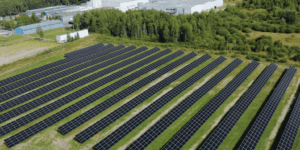A major solar energy plant – AkzoNobel’s (Amsterdam, the Netherlands; www.akzonobel.com) largest in Europe – has been installed at its Pilawa site in Poland, further powering the company’s efforts to transition all its production locations to renewable electricity.
Covering nearly three hectares (around the size of four football pitches), there are 3,551 solar panels, with an installed capacity of 1.9 MWp. They’ll provide nearly a quarter of the decorative paints facility’s electricity needs.
“We’re committed to realizing our science-based target of halving our carbon emissions across the full value chain by 2030,” says Janusz Karwowski, Manufacturing Director of AkzoNobel’s Decorative Paints East Europe business. “This investment will increase our momentum as we continue to combine transitioning to renewable electricity sources with achieving our business goals.”
The new installation is one of a number of significant recent investments in Pilawa, which have included automating the solvent paint filling and raw material dosing processes.
“The company has been operating on 100% renewable electricity in Europe since January 2022 and more than 30 sites around the world now use solar panels as a supplementary source of energy,” adds Wijnand Bruinsma, AkzoNobel’s Director of Sustainability. “We’re in the process of increasing this number significantly as part of a global program and Pilawa represents another successful step in the right direction.”
Another solar project was recently completed in the Czech Republic, where 1,300 panels have been installed at the company’s Opava powder coatings site. Covering nearly 2,800 square meters, the plant has an installed capacity of 574 kWp and will generate around 15% of the facility’s total energy needs.
In addition to Europe, AkzoNobel also operates on 100% renewable electricity in South America (since late 2023) and North America (since early 2023). The company’s overall ambition is to achieve 100% renewable electricity in its own operations by 2030.
